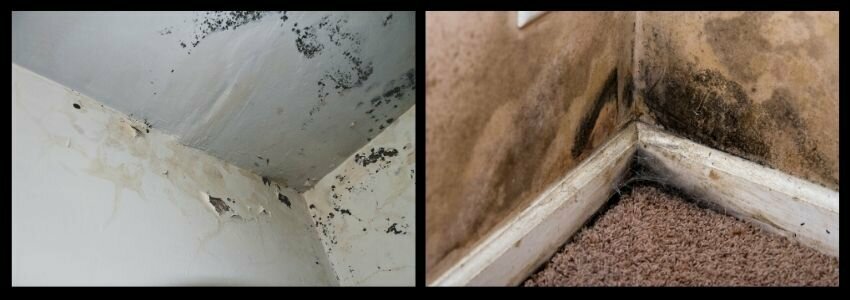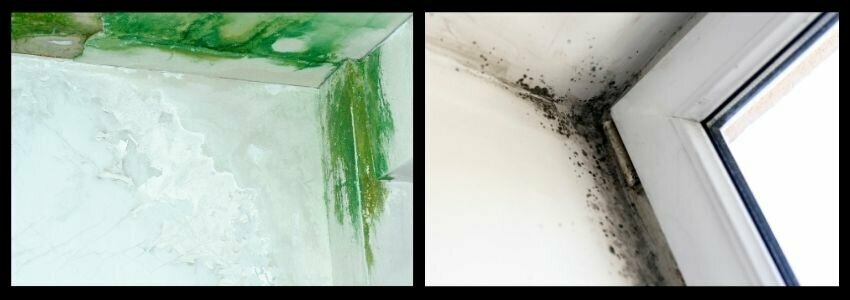There is no clear number of exactly how many types of mold exist in the world, but experts estimate that as many as 100,000 or more types of mold exist — and many of them can show up in your home. So what do you do if you are trying to sell your house and discover a mold problem? What are your options? Read below for everything you need to know about selling a home with mold including black mold, green mold and so forth.
The Problem With Mold in Your Home

Mold, a naturally occurring microscopic fungi is an opportunist. The teeny tiny organism can be found anywhere and will grow on almost anything if it is moist enough. This makes mold a likely problem in areas like bathroom walls, around windows or attics. The mold can show up as a furry growth or a black stain, specks of black, white, green, brown or orange. The good news is that mold isn’t always hazardous, but certain types or even in certain quantities mold means no good for the residents of the home. But you might be wondering if it’s even legal to sell a house with mold?
Selling a House with Mold-Is it Legal?
Selling a house with mold can be a complex matter that depends on various factors, including state and local laws, the severity of the mold infestation, and disclosure requirements. Here, we’ll delve into the legal aspects of selling a house with mold and outline the key reasons why it may or may not be legal:
Reasons Why It May Be Legal to Sell a House with Mold:
- No Disclosure Laws: In some states or regions, there may be no specific laws requiring sellers to disclose mold issues to buyers. However, this can vary widely, so it’s crucial to understand your local regulations.
- As-Is Sale: If the seller clearly states that the property is being sold “as-is,” it may absolve them of responsibility for mold issues. Buyers who purchase a property “as-is” are typically accepting it in its current condition, including any mold problems.
Reasons Why It May Not Be Legal to Sell a House with Mold:
- Health and Safety Concerns: Mold can pose health risks to occupants, and knowingly selling a house with mold without disclosure may expose the seller to legal liability if occupants suffer health issues as a result.
- State Disclosure Laws: Many states have specific laws mandating the disclosure of known mold problems during a real estate transaction. Failing to disclose mold when required can lead to legal consequences.
- Property Condition Laws: Even in the absence of specific mold disclosure laws, general property condition laws may apply. If the mold issue is significant enough to affect the habitability or structural integrity of the property, it could be deemed a violation of these laws.
- Fraud and Misrepresentation: Selling a house with concealed mold issues can be considered fraud or misrepresentation. If the seller is aware of the mold and actively conceals or misrepresents it, they may be held legally accountable.
- Financing and Insurance Issues: Lenders and insurers often require inspections before approving loans or coverage. If mold is discovered during these processes and not disclosed, it can affect financing and insurance agreements.
- Buyer’s Right to Inspections: Buyers typically have the right to inspect a property before purchase. If they discover mold issues during their inspection and the seller did not disclose them, it could lead to legal disputes.
- Rescission of Sale: In some cases, buyers may have the right to rescind the sale or seek damages if mold issues are discovered after the transaction and the seller failed to disclose them.
There are three main classifications of mold:
- Pathogenic. This type of mold can cause serious infections and will affect both weak and strong immune systems.
- Allergenic. This type of mold is not as harmful, especially in small quantities, but it can trigger allergic reactions and cause symptoms in persons with asthma.
- Toxigenic. This mold has mycotoxin which is harmful to a person’s health.
The most common type of toxic mold is black mold with asthma suffers or those with weakened lungs experiencing the most severe reactions to the mold. Overall serious health problems from indoor molds are (thankfully) not common. You might experience a response similar to seasonal allergies with sneezing a runny nose or coughing, or you might have no symptoms at all.
The fact that you do not get sick from your mold does not mean it’s harmless, nor does it mean a potential buyer will be willing to look the other way about a mold problem, big or small. Mold carries a big stigma that would turn away many potential home buyers.
Diagnosing and Treating Your Mold Problem

If you can see mold then it’s clear you have a problem. Keep in mind however that checking for mold if you’ve had a recent leak might not be as easy to identify. Mold thrives in crawlspaces , basements and attics when leaking is involved so you should always consider hiring a professional for a mold inspection.
Before listing your home, inspect your home carefully and thoroughly. Pay attention to areas where moisture might accumulate or areas that don’t get visited often. If you think there is even a possibility that a recent or unnoticed leak could have created the opportunity for a mold contamination then you can hire a professional to get an inspection done.
When it comes to dealing with the problem yourself, the general advice is that if the mold covers an area of 10 square feet or less then you can take steps to rid yourself of mold without necessarily calling in the professionals. The do-it-yourself way means using a mixture of bleach and small hand tools. Other household cleaners such as vinegar, baking soda and tea tree oil are also used to deal with mold. This will save you money in the long run but do your research well — bleach solutions tend to only handle mold growth and not the spores. When the mold is feeling attacked it will send out spores into the air leading to a potential cross-contamination in your home, especially if the area still attracts moisture, allowing the mold to regrow somewhere new in your home.
Hiring a Mold Remediation Pro
A simple google search will bring up a host of mold remediation companies. You can anticipate that a professional would use plastic shielding to contain the affected part of your house to prevent cross-contamination. A professional company would bring in expensive equipment like HEPA air cleaners, HEPA vacuums and commercial-grade dehumidifiers to clean all surfaces and clear the air of spores. Hiring a remediation company also means that the area will be treated with a sealer to make the area more resistant to water damage and potential mold problems in the future. These services are often warrantied for a number of years and are the only way to deal with a large-scale mold problem correctly. A potential home buyer would be reassured to have documentation of a professional mold remediation company having dealt with the problem.
Mold Disclosure to Potential Buyers

A home inspection report will detail any current mold problems you might have to potential buyers. If the mold problem was in the recent past then make it a point to disclose everything to the buyer and keep detailed documentation of all the steps taken to solve the mold issue. Documenting includes all repairs made and any tests done as well as the test results. Having clear documentation shows the buyer that you have dealt with the problem in a thorough manner and they protect you from any legal action like a lawsuit, if the buyer purchases the home and has mold issues. Documentation will protect you and give peace of mind to potential buyers.
Selling a Home With Black, Green or Other Mold
The reality is, a home with black, green or other mold problems is going to be a hard sell. Traditional home buyers are cautious of anything that might harm their health or that of their family or cause significant financial problems in the future. A home is a big purchase and a potential buyer will easily walk away from a home with mold listed as a home inspection problem.
To sell your house with a mold problem keep in mind that you’ll have to reduce the price (though the severity of the reduction will depend on the extent of the problem).
One way to get a better sale price is simply to deal with the mold head-on and hiring a professional company to deal with the problem, keeping all of the documentation and ensuring a warranty. While the word “mold” might still strike fear in the hearts of many buyers, having a clearly documented, professionally treated, mold problem in the past won’t scare away the right buyer.
Selling a House With Mold to a House Buying Company
If you don’t have the cash to take care of the mold problem up front, or you have a recurring mold problem that you haven’t been able to clear up, you can also consider working with a non-traditional buyer. We are your local, top rated Utah House buying company. We are not scared away by problems like mold and will make a fair cash offer and take on the risk and time of fixing the mold issue themselves. As a non-traditional buyer, we are much more open to dealing with less-than-perfect homes and are used to working with remediation companies to solve problems like mold.

Thanks for sharing. For people sensitive to mold, inhaling, or touching mold spores can cause allergic reactions, including sneezing, runny nose, red eyes, and skin rash. People with serious mold allergies may have more severe reactions, including shortness of breath.
Regards,
Kurt Haas